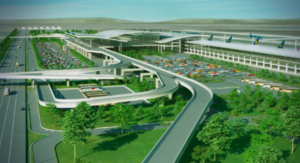A significant wave of private investments are flying into aviation infrastructure on the back of improvements in long-term development planning for the sector in Vietnam.
With the master plan to operate 28 airports by 2030, including 15 domestic and 13 international ones, in which Noi Bai, Da Nang, Cam Ranh, Tan Son Nhat and Long Thanh are key international gates, Vietnam is attracting investors to pour money into aviation infrastructure projects.
The Imex Pan-Pacific Trading Group, chaired by Johnathan Hanh Nguyen, has recently sent a document to Minister of Transport Nguyen Van The proposing to join the Airports Corporation of Vietnam (ACV) to invest in Passenger Terminal (T3) at Tan Son Nhat International Airport.
This is the second time this year Johnathan has expressed such a desire.
Meanwhile, the real estate developer FLC Group of Trinh Van Quyet is also interested in investing in the aviation sector. The group has received approval in principle from authorities in the central province of Quang Binh to invest in and upgrade Dong Hoi to an international airport.
The provincial People’s Committee said the project would be implemented under a public-private-partnership (PPP) model.
Quang Binh authorities and FLC Group have jointly asked the transport ministry to approve the project, which is expected to raise capacity from 500,000 passengers to ten million by 2020.
One of the typical examples of increased private investment is Van Don International Airport. The airport is the first private one in Vietnam invested in the form of BOT (Build-Operate-Transfer), with investment capital of VND7.5 trillion (USD321.4 million).
The airport is directly invested and operated by Sun Group.
The aviation services at the airport are still managed by the State in accordance with law.
Van Don is approved by the Ministry of Transport (MoT) as an airport of grade 4E (according to ICAO standard code). It is modern with a 3.6km long, 45m wide landing strip and is capable of accommodating large cargo and passenger aircraft. Van Don Airport is scheduled to begin operation this Sunday.
In their latest report, experts from Vietcombank Securities (VCBS) said they witnessed a trend of privatisation in infrastructure investment.
“This trend on one hand reduces pressure on the state budget and improves service quality, on the other hand, it creates a less positive sign for businesses with a large market share in the industry when the market is shared,” said experts fromVCBS.
VCBS experts also assessed that aviation infrastructure had not caught up with the industry’s development. The total passenger transport market of Vietnamese airlines is predicted to increase by an average of 16 per cent per year by 2020 and 8 per cent in the period 2020-30.
The passenger transport volume in 2020 and 2030 is 64 million and 131 million, respectively, according to the transport ministry’s forecast.
Meanwhile, this year witnessed the five biggest airports of Vietnam, Tan Son Nhat, Noi Bai, Da Nang, Cam Ranh and Phu Quoc, all serving passengers exceeding their designed capacity. In particular, Tan Son Nhat Airport exceeded the figure by 40.7 per cent.
“Despite improvements in technology, the process partially meets the increasing number of passengers each year, the expansion and upgrades to these airports is still an indispensable requirement,” VCBS stressed.
According to ACV, in the period 2018-25, there will be 15 key airports that will receive upgrades. Construction works will also be undertaken on Long Thanh International Airport in phase 1 and new passenger terminals for Dien Bien, Na San and Lao Cai airports.
It is expected that the total investment of terminal and apron projects (excluding Long Thành Airport) amounted to more than VNÐ56.7 trillion with capital accumulated from ACV’s business activities. In addition, it needs more than VNÐ20.7 trillion to invest in the airfield projects, with capital accumulated from this area.
In the above projects, investment priority will belong to Tan Son Nhat Airport.
According to Deputy General Director of Vietstar Airlines Luong Hoai Nam, quoted by online newspaper vnexpress.vn at the Vietnam Travel and Tourism Summit held early this month in Hanoi, since 1975, Vietnam has only really built completely and put into operation Phú Quoc Airport and most recently Van Don Airport, the rest are mostly upgraded from military airports with limited land funds, making the ability to expand very slight.
Vietnam has 21 airports, while Thailand has 38. The capacity of all Vietnam’s airports is 75 million passengers per year, which is just one-third of Thailand’s. The combined capacity of all airports in Vietnam is that of Changi Airport of Singapore or Kuala Lumpur of Malaysia.
Source: Borneo Bulletin



 The Aviation Corporation of Vietnam (ACV) and local authorities in the central province of Thua Thien-Hue have agreed to invest 95 million USD in the expansion and upgrade of Phu Bai Airport.
The Aviation Corporation of Vietnam (ACV) and local authorities in the central province of Thua Thien-Hue have agreed to invest 95 million USD in the expansion and upgrade of Phu Bai Airport. The northern mountainous province of Lao Cai has proposed the Ministry of Transport build a civilian and military airport in Sapa.
The northern mountainous province of Lao Cai has proposed the Ministry of Transport build a civilian and military airport in Sapa. Located in one of the SEZ areas, Van Don is the first airport in the country built with locally mobilized capital.
Located in one of the SEZ areas, Van Don is the first airport in the country built with locally mobilized capital.